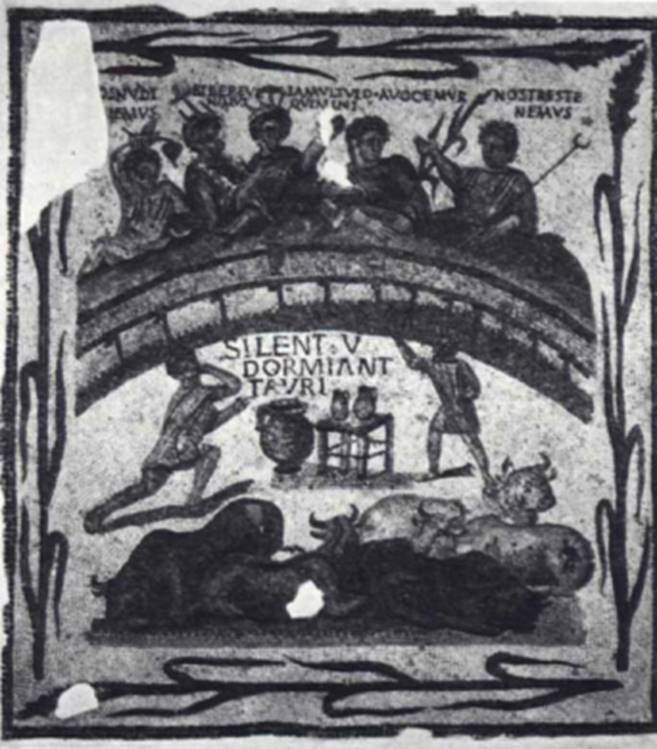Emblema with banquet of gladiators. Thysdrus (El Djem, Tunisia), about 220-250 Mosaic
A rich palette of red, green, yellow, brown, and black tesserae has been used to depict a vivid scene of men and animals, posed against a white ground and framed by millet stalks within a narrow border. Cast shadows, highlights, and modeled contours preserve the vestige of an illusionistic tradition already moving toward abstraction, a development confirmed by the irrationality of the shadows and the prominence of the tesserae as colored stones. This mosaic panel follows the pattern of emblemata, which were inserted in a decorative scheme and were both narrative and symbolic.

Five men in colorful costume, variously crowned and holding different attributes, are engaged in a drinking bout, seated at a banquet table, whose curving shape and columnar front suggest the arena. The man at the far right seems to be the head of the table; he holds a crescent-topped staff and animatedly addresses his companions, who gesture as they reply. Their talk has been recorded by the upper inscription in the fashion of a comic cartoon: (N)os nvdi (F)iemvs/ bibere venimvs/ IA(m) MVLTV(m) loqvimini/ avocemvr/ nos tres tenemvs (“We're going to be naked/ we're here to drink/ we're talking a lot/ we'll be called away/ we're holding our three [glasses]'').
In the middle ground a slave hands a glass (of wine?) to the celebrants above, while a second slave comes from the left, calling out: silentivm dormiant tavri (“Keep quiet! Let the bulls sleep"). Below, five bulls nestle together in sleep, each of them branded on the hindquarters; the humped backs mark them as zebus, the fierce African animals favored for the venatio in the arena.
The shape of the table, the branded zebus, the attributes and shouts of the drinkers indicate a party held by the venatores the night before they combat animals, perhaps the same shown sleeping, in the great amphitheater of El Djem, which still survives. Gladiatorial contests, especially the hunt, were very popular in Roman Africa.
Beyond the level of popular imagery, however, the prophylactic elements (millet stalks, the crescent scepter, the number “tres") suggest a deeper meaning involving the contrast between the joyful celebration of good times today and the dangerous activities of tomorrow. The expression “silentium dormiant tauri" appears in other Tunisian mosaics of the period and may be proverbial in the sense of “let sleeping dogs lie." Since these words appear in the center of the mosaic in larger letters than the upper inscription and since the mosaic itself comes from a private house, it is likely that this emblema had a general significance as a guide to life: "Eat, drink, and be merry, for tomorrow we may die." Bibliography: Salomonson, 1960; Washington, D.C., 1967, no. 19; Grabar (1), 1968, p. 16, fig. 36.
Date added: 2025-07-10; views: 180;
